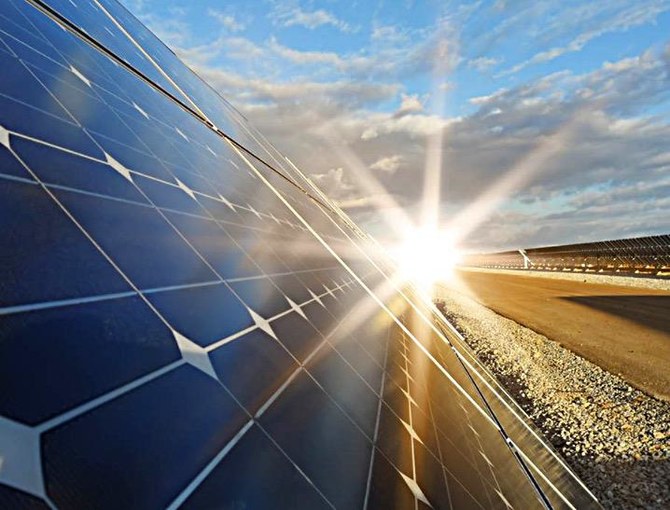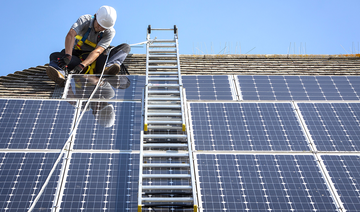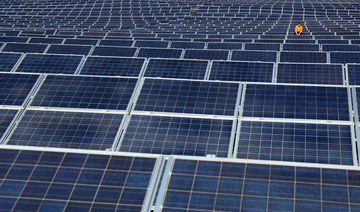DUBAI: In the past decade, the world has witnessed a pressing need for a major transformation from conventional energy sources to renewables starting with planned efforts in limiting the global temperature from rising to 2.0ºC (3.6˚F) for the present century.
A number of producer economies have recognized the need to diversify their energy production while simultaneously seeking to diversify their economies by putting energy transitions at the heart of their development strategies. Saudi Arabia, the world’s largest oil exporter, has, in turn, experienced an emergence of a solar sector as part of its economic diversification plans under the Kingdom’s Vision 2030.
Saudi businessman Khaled Ahmad Sharbatly, the managing partner of Desert Technologies, which specializes in solar energy, offers insight into how the launch of the solar industry in the Kingdom prompted business development and outlines both the opportunities and barriers for the country’s expansion into “yellow gold.”
In addition to his position in Desert Technologies, Sharbatly, 26, has undertaken courses at the UN, Harvard Business School, Harvard Law, and completed a fellowship from the International Monetary Fund that was only given to 20 people around the world. He holds two posts, one in the Chinese-Saudi Business Council and another in the industrial council of the Jeddah Chamber of Commerce, where he is leading the team for the general overview of sustainable manufacturing that is focused on supporting industries that have been affected by coronavirus (COVID-19) pandemic and how they can have a sustainable recovery.
Having spoken at over 15 international conferences, including the Business Twenty (B20) the official business community engagement forum for the Group of Twenty (G20), the World Future Energy Summit (WFES), Intersolar, and others within the span of two years, Sharbatly describes himself as an active sustainability and renewable energy influencer that promotes sustainable development initiatives within personal and professional environments.
While the Kingdom’s Vision 2030 provides for the transformation of Saudi Aramco into a multi-sectoral industrial powerhouse, private solar firms, such as Desert Technologies, have already sprung with growing expectations about the market, carving their position within the industry with projects in 26 countries worth more than $200 million.
Sharbatly said that his decision to dive into the renewable energy industry was prompted by the Vision 2030 goals of revolutionizing environmental sustainability, which ultimately leads to the capitalization of the growing demand for sustainable investments.
“In 2016, when the initial draft of the Saudi Vision 2030 was released, I took a look at that draft and I saw where our country was heading in the next 15 years,” Sharbatly said.
“I saw that sustainability was a huge component of it. Getting out of fossil fuels and into renewable energy is an area of huge strength for the Kingdom because we are the energy suppliers of the world.
“So if we change from fossil fuels to gas, from gas to hydrogen, from hydrogen to solar or from solar to wind, it would be indifferent as we can build the industry, given that we have the supply chain, the logistics and the full infrastructure for that. It is much more attainable than many other industries, and in terms of logistics, we have two of the largest ports in the red sea, almost 70 percent of the world’s trade goes through us.”
Saudi Arabia’s socio-economic development in recent decades has been driven by oil-and-gas revenues. The vast wealth it pumped out was a major contributor to the government’s budget revenues, paying not only for the glistening skyscrapers but also for a government sector that employs a high percentage of Saudis.
With its vast deserts, the Kingdom is now linking its future to another natural resource it has in even greater abundance: sunlight.
The Saudi government has set a target of generating 9.5 gigawatts (GW) of renewable energy by 2023, which will generate enough electricity to power around 40,000 homes.
“Even though we have an impressive natural potential for solar and wind power, and our local energy consumption will increase threefold by 2030, we still lack a competitive renewable energy sector at present. To build up the sector, we have set ourselves an initial target of generating 9.5 gigawatts of renewable energy,” a Saudi cabinet statement said on the Saudi Vision 2030.
Forming part of the GCC, Saudi Arabia lies within the so-called “global sunbelt” and has some of the highest solar irradiances in the world with over 3,000 hours of sunlight annually. Around 60 percent of the region’s surface area has been found to have a particularly high level of suitability for solar PV deployment, according to the International Renewable Energy Agency (IRENA).
“Currently we work through the company’s factory in Jeddah to collect and market solar panels produced in Saudi Arabia for use in multiple facilities such as schools, exhibitions, mosques, factories, warehouses and soon homes all over the Kingdom to reduce the kilowatt price for companies and individuals,” Sharbatly said.
Representing a firm that is taking advantage of its country's most abundant clean-energy source, Sharbatly said Desert Technologies builds the smart infrastructure of the future, powered by the sun.
“Smart infrastructure is a wide array of products and services to be developed, constructed, or manufactured and that is what we do — we manufacture, we develop and we construct,” Sharbatly said. “We manufacture solar panels, we manufacture power plants, invest in power plants by selling electricity and we construct plants.
“Today, we will invest in smart infrastructures such as utility-scale projects or the regular solar panel projects that can be seen on roofs or grounds. Solar plus battery, solar plus diesel, hybrid systems, and also powering vehicles using renewable energy, because we think there is a huge field where we are trying to be sustainable and buy electric vehicles. But we are powering them using conventional electricity, or we buy energy-efficient refrigerators that save money, which defeats the objective,” Sharbatly said.
Smart infrastructure essentially leverages data and digital connectivity to improve certain functions, including sustainable energy management. That aims to help in achieving a lower carbon footprint through the production of more efficient infrastructure and planning.
“We are trying to power all these products that have already taken a step towards sustainability with real sustainable sources of energy. It is solar today, but in the future, it could be something else as we are flexible and technology agnostic,” Sharbatly said.
“Sustainability is Vision 2030 — how can we build a country that is not dependent on one major source of income but have sustainable development across all sectors such as social, governmental, environmental, commercial, for the future,” Sharbatly said.
“The country’s location and climate mean it has plenty of promising sites for solar and even wind farms.”
The abundance of solar resource potential primarily indicated by its strategic location, accompanied by the recent fall in global oil prices and the falling cost of associated technologies, such as photovoltaic (PV) modules are major factors influencing the appeal of solar energy in the country. The costs of installing and operating such technologies have fallen drastically around the world in recent years, which means that even in a country where oil is copious, renewables still beckon as a cheap and clean alternative to traditional fossil fuels.
“Today solar is around 90 percent cheaper than oil and gas,” Sharbatly said.
“The first step onwards to this transition is hybrid solutions. Hybrid solutions are the first gateway to complete renewable energy or a 100-percent clean energy future. Today we have oil, we have power plants, we have diesel generators and we are not going to replace them as the energy demand is increasing, even if it is at a small rate. It is still increasing and we cannot convince people to throw away investments that they have made and bring something else when they have not made the return yet. This is the world view, not just my view. We have to transition into sustainability and into a sustainable grid powered by sustainable energy sources.”
The initial driver behind the Saudi government’s interest in the use of solar power was its intention to diversify its energy mix towards alternative sources, including renewables in order to preserve domestic energy production for export amid rising domestic consumption of oil for power generation.
“Oil, coal, gas, or any other source of energy will never, at least for the next 100 years, be out of the energy mix,” Sharbatly said. “We will use these fossil fuels to create all sorts of products. That's the true value of fossil fuels — to create value and products, instead of burning them to create electricity. We can make electricity in cheaper, cleaner ways.”
The global population is expected to reach 9.7 billion by 2050, which is a 1.9 billion increase from 2020, according to the UN. Concurrently, as urbanization continues, the proportion of the population living in urban areas will increase to around 66 percent by 2050, up from 30 percent in 1950.
Saudi Arabia’s capital Riyadh will at least double in size from its current population of around 7.5 million people by 2030. The country’s population will reach 45 million by 2050, implying a population increase of about 13.5 million from 2015. Meanwhile, the proportion of the urban population will increase at a dramatically higher rate than other countries, to under 90 percent by 2050, according to the UN Department of Economic and Social Affairs.
This high rate of population growth and urbanization has driven a rise in domestic energy and electricity demand. Peak electricity load in Saudi Arabia, for instance, has been rising by 7 percent every year. Electricity consumption has grown from 186.5 Terawatt hour (TWh) in 2008 to 345.05TWh in 2018, according to International Energy Agency (IEA) data. Further increase in such trends inevitably poses significant questions for sustainability and is anticipated to place unparalleled pressures on energy demand and supply.
In line with these trends, Desert Technologies has started working on the expansion of its factory from 100 MW to 200 MW yearly production, which is indicative of the heightened demand for renewables in the region. In 2021, the company plans to increase its presence within the Middle East and signed four projects by February. Two of the projects are in Saudi Arabia, one is in Bahrain and the one in Egypt is set to be completed by 2022.
The firm’s goals for the next five years echo such expansions, with intentions of accumulating projects in the Middle East and Africa. In Asia, Desert Technologies will be doing up to $3.5 billion of work, with a specific focus on the small to medium scale on-grid and off-grid solutions, according to Sharbatly. It also plans on releasing two other companies, one of which is a development company that will be released as a joint venture.
Furthermore, the firm seeks to grow in Southeast Asia and Latin America to further build its track record. Sharbatly mentioned Japan as a particular country of interest.
“They are very advanced in technology and there is an incredible relationship between Saudi Arabia and Japan,” Sharbatly said. “There is a big presence of Japanese companies, bands and investors in Saudi and vice versa. We are amazed by how advanced they are. Also, we like their work ethic, we like their honesty and culture, all of which we think fits with ours.”
Sharbatly then discussed why renewable energy is not being utilized fully in Saudi Arabia, despite the availability of necessary resources and the challenges associated with such an energy transition.
“To localize an industry is not an easy job and Saudi is trying to start where everyone else has finished,” he said.
“It requires a huge investment in infrastructure, training, building facilities because it is pointless to invest in building power plants or to allow companies to come and bid for building power plants when the jobs they are going to be making as a developer or contractor are short-term jobs. The strategic value in localizing an industry is creating manufacturing industries where there are long-term jobs that require highly skilled people and require universities and highly skilled programs to really support the training of these people. Just like we have excelled in oil and gas, we can excel in this.”
Sharbatly said COVID-19 has delayed the process.
“It needs time — time to build state-of-the-art facilities, to sign with suppliers from around the world and localize the industry,” he said. “The government right now is really focused on health and saving the lives of its people, but hopefully in the upcoming year and in 2022 there will be a lot of very good news on new manufacturing facilities, including ours.”
Another reason such a transition requires time is those energy transition pathways that imply an imminent peak and then a steep drop in oil demand would result in sharply reduced revenues for many countries.
This year’s coronavirus-induced decrease in oil demand and the subsequent impact on prices put this challenge in stark relief. It demonstrates not only the effect a rapid transition would have on the world economy, but also provides an admonitory observation of the future if success is not achieved in the diversification efforts of key producer economies.
Pointing out that once electricity is generated, it cannot be stored, except in limited amounts using batteries, but can be sent long distances across the grid, Sharbatly said: “Storage today is quite competitive, especially from unsubsidized energy. In countries like Saudi or the GCC, storage is very difficult because it is more expensive than the energy you get from the government, while in Africa it is much cheaper.”
The storage of excess energy produced still presents a problem due to limited storage capacities and overproduction that can result in losses. Consequently, one of the main objectives of building sustainable smart infrastructure is to enable the adaptation of energy production to actual demand. This entails the achievement of demand-oriented production that can, with proper infrastructure and planning, allow immediate consumption of produced energy.
The development of different sectors of smart infrastructures, such as smart energy and smart transportation would enable the accumulation of real-world data that can be interconnected for use among different services.
Desert Technologies also plays a role in assisting Saudi Arabia in becoming a renewable-energy exporter and supplier through their major operations in developing and emerging markets that use solar PV panels manufacturing in the country.
For example, Desert Technologies was a co-developer for several solar photovoltaic projects in Benban, Egypt, which is one of the world’s largest solar farms. This includes the ARC Project, which has the capacity to generate 65.7 megawatt (MW) of energy, the Winnergy Project, with a 24.9MW generation capacity and the Arinna Project, with a 24.9MW generation capacity. The electricity generated from these plants is sold to the Egyptian Electricity Transmission Company (EETC) under a 25-year power purchase agreement. Cumulatively, Benban’s fields consist of 6 million panels that produce 1.5 gigawatts (gw) of energy, which is enough to power more than one million homes.
While many countries are now exploring ways to stimulate social and economic growth through the development of the renewable energy sector within their own parameters, Desert Technologies has chosen to target less economically developed countries to promote sustainable economic development.
In 2019, there were 771 million people without electricity access, which was a record low. This was enabled through the use of grid electrification as the primary source of energy access gained since 2000, according to data from World Energy Outlook 2018. Despite such progress, the world remains far from achieving SDG targets to ensure universal access to affordable, reliable and modern energy services by 2030. The population without access to electricity in Sub-Saharan Africa remains at 579 million, amounting to 56 percent of the population.
The manufacturing division at Desert Technologies called “DT Labs” invests in research and development to create new and better solutions. The current areas of infrastructure innovation include the development of solar-powered electric vehicle charging stations and solar street lamps that can provide Wi-Fi and phone charging services. The company is also developing mini-grid systems that reuse lithium-ion batteries, from cars or computers, to build economic and efficient mini-grid and off-grid solar systems in Africa.
The challenges associated with electricity provision in developing countries extend beyond the sphere of private investment and involve difficulties associated with infrastructure. The innovative approaches to solving the problem by Desert Technologies demonstrate how international investments in renewable energy can provide key resources and help in the creation of enabling environments through the provision of sustainable, efficient, and equitable electricity in regions critical to the global climate future.
The oil and gas producers in the Middle East and North Africa region are conscious of the potential adverse impacts of climate change and the impact it will have on their economies, given their current dependence on oil and gas revenues. This makes the way in which the increasing energy demand across the region is met highly significant, and the argument for renewables, particularly solar PV, in obtaining a larger role in the energy mix, even more compelling.
Desert Technologies, with its ambitious projects that are already yielding results throughout the region, serves as one example of how the Kingdom can leverage its abundant resources, domestic expertise and competitive advantage in energy production. Linking energy and industrial transformations to optimize new opportunities will simultaneously position Saudi Arabia in the new energy market.






















